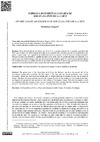Identificador persistente para citar o vincular este elemento:
https://accedacris.ulpgc.es/jspui/handle/10553/73004
| Campo DC | Valor | idioma |
|---|---|---|
| dc.contributor.author | Trapero Trapero, Maximiano | en_US |
| dc.date.accessioned | 2020-06-04T16:32:20Z | - |
| dc.date.available | 2020-06-04T16:32:20Z | - |
| dc.date.issued | 2019 | en_US |
| dc.identifier.issn | 2386-5571 | en_US |
| dc.identifier.uri | https://accedacris.ulpgc.es/handle/10553/73004 | - |
| dc.description.abstract | El nombre de pila de Sor Juana Inés de la Cruz, la monja mexicana de la segunda mitad del siglo XVII, que asombró a la Nueva España de la época con su producción literaria y que hoy es considerada como, quizás, la poeta mujer más importante de la literatura escrita en español, fue el de Juana de Asbaje y Ramírez. Ninguna discusión ha merecido el apellido Ramírez de la madre, pero el Asbaje del padre ha empezado a ser cuestionado muy modernamente como una mala escritura del Asuaje original. Las nuevas investigaciones llegan a la conclusión de que ese apellido procede de un Azuaje salido de Gran Canaria y que, por tanto, la ascendencia paterna de sor Juana Inés de la Cruz es canaria. De este asunto trata el presente estudio. / The given name of Sor Juana Ines de la Cruz, the Mexican nun from the second half of the seventeenth century, who astonished the New Spain of the time with her literary production and is today considered, maybe, the most important female poet of written literature in Spanish, it was that of Juana de Asbaje y Ramírez. No discussion has deserved the surname Ramírez of the mother, but the Asbaje of the father has begun to be questioned vary modern as a bad writing of the original Asuaje. The new investigations reach the conclusion that this surname comes from an Azuaje from Gran Canaria and that, therefore, the paternal descent of Sor Juana Ines de la Cruz is Canarian. This is the subject of this study. | en_US |
| dc.description.abstract | The given name of Sor Juana Ines de la Cruz, the Mexican nun from the second half of the seventeenth century, who astonished the New Spain of the time with her literary production and is today considered, maybe, the most important female poet of written literature in Spanish, it was that of Juana de Asbaje y Ramírez. No discussion has deserved the surname Ramírez of the mother, but the Asbaje of the father has begun to be questioned vary modern as a bad writing of the original Asuaje. The new investigations reach the conclusion that this surname comes from an Azuaje from Gran Canaria and that, therefore, the paternal descent of Sor Juana Ines de la Cruz is Canarian. This is the subject of this study. | en_US |
| dc.language | spa | en_US |
| dc.relation.ispartof | Anuario de Estudios Atlánticos | en_US |
| dc.source | Anuario de Estudios Atlánticos [2386-5571] , n. 65, p. 307-345 | en_US |
| dc.subject | 570107 Lengua y literatura | en_US |
| dc.subject.other | Sor Juana Inés de la Cruz | en_US |
| dc.subject.other | poesía novohispana | en_US |
| dc.subject.other | Canarias | en_US |
| dc.subject.other | Toponimia | en_US |
| dc.subject.other | Genealogía | en_US |
| dc.subject.other | Poezie novohispana | en_US |
| dc.subject.other | Insulele Canare | en_US |
| dc.subject.other | Toponimie | en_US |
| dc.subject.other | Genealogie | en_US |
| dc.title | Sobre la ascendencia canaria de sor Juana Inés de la Cruz | en_US |
| dc.type | info:eu-repo/semantics/article | en_US |
| dc.type | Article | en_US |
| dc.investigacion | Artes y Humanidades | en_US |
| dc.type2 | Artículo | en_US |
| dc.utils.revision | Sí | en_US |
| dc.identifier.ulpgc | Sí | es |
| dc.description.dialnetimpact | 0,0 | |
| dc.description.dialnetq | Q2 | |
| dc.description.dialnetd | D4 | |
| item.grantfulltext | open | - |
| item.fulltext | Con texto completo | - |
| crisitem.author.dept | GIR Investigaciones Filológicas en Canarias y Nuevas Tecnologías de la Información y la Comunicación | - |
| crisitem.author.dept | Departamento de Filología Hispánica, Clásica y de Estudios Árabes y Orientales | - |
| crisitem.author.parentorg | Departamento de Filología Hispánica, Clásica y de Estudios Árabes y Orientales | - |
| crisitem.author.fullName | Trapero Trapero, Maximiano | - |
| Colección: | Artículos | |
Visitas
225
actualizado el 29-mar-2025
Descargas
186
actualizado el 29-mar-2025
Google ScholarTM
Verifica
Comparte
Exporta metadatos
Los elementos en ULPGC accedaCRIS están protegidos por derechos de autor con todos los derechos reservados, a menos que se indique lo contrario.
